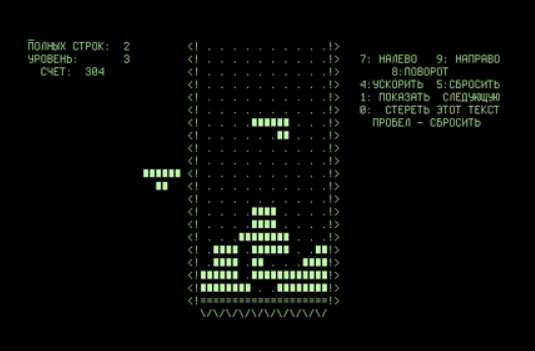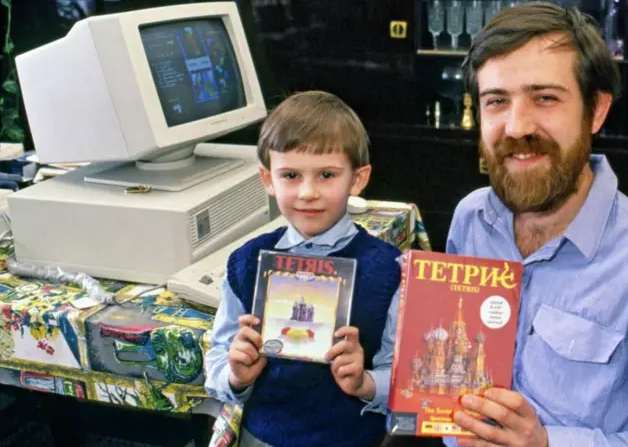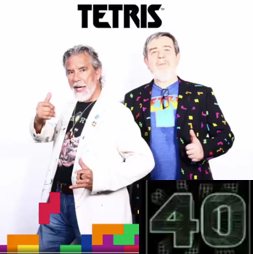| Tetris - Still A Winner After 40 Years |
| Written by Sue Gee | |||
| Sunday, 16 June 2024 | |||
|
Tetris, the classic and addictive puzzle game where you rotate and position falling blocks, has been played by at least a billion people. It was invented 40 years ago and to mark the occasion the BBC News in Russian website reveals the story of how Tetris crossed the Iron Curtain and discloses how it was finally "won" this year. Alexei Pajitnov was 29 in 1984 and had worked since 1979 at the Computer Center of the Soviet Academy of Sciences as a speech recognition researcher, a job that required him to test the capabilities of new hardware. It also gave him access to an Electronika 60 which enabled him to develop games. Inspired by pentomino tiling puzzles, which use 5 squares per geometric shape, Pajitnov settled on 4 squares, and restricted the number of shapes to 7 rather than the full number (12) possible options. These shapes fall down a column and the player must move and rotate them to complete horizontal rows. Pajitnov titled the game Tetris, a word created from a combination of "tetra" (four) and his favorite sport, "tennis". The Electronika 60 had no graphical interface, so Pajitnov modelled the field and pieces using spaces and brackets and, as completed lines quickly filled the screen, Pajitnov decided to delete them, creating a key part of Tetris gameplay. This is how the original concept looked: The first primitive version, which lacked both levels and scoring, was ready on June 6, 1984 and the almost complete absence of personal computers in the Soviet Union at that time did not prevent the spread of the game, one computer to the next. Despite copyright law of the Soviet Union denying Soviet researchers rights to sell their creations, Pajitnov wanted to export Tetris. Having, approached his supervisor Victor Brjabrin for help Pajitnov offered to transfer the rights of the game to the Academy, and in 1986, Brjabrin sent a copy of Tetris to Hungarian game publisher Novotrade which established its popularity in Hungary and Poland. How Tetris, and later Pajitnov himself, reached the USA, is told, in Russian, in a recent post on the BBC News. It recounts that in 1989, American programmer Henk Rogers, who was working in Japan at that time, came across Tetris during a business trip to Hungary and recognized its market potential. It order to obtain an license Rogers went to Moscow where his driver and interpreter, took him to Elektronorgtekh, a Soviet institution that imported and exported equipment and software. but refused to accompany him inside saying she was "not invited there". Once he managed to convey the message that he was interested in buying the rights to Tetris, he was immediately introduced to Alexei Pajitnov - in the presence of eight other people, including KGB officers. Although it was difficult to get Soviet officials to understand the concept of copyright in video games, which at that time was largely incomprehensible and completely alien to them, Rogers made a good impression on Pajitnov and after a week of negotiations, a contract was signed that guaranteed the Soviet inventor something unheard of - a personal share of the profits from all sales of the game abroad. In the event, the promised income stream failed to be reliable, but in the mid-1990's Pajitnov moved to the United States, created a company with Rogers and finally began receiving royalties. Meanwhile Tetris flourished as a game not only on Nintendo handheld consoles but on every conceivable platform and became a worldwide phenomenon. It has a strong competitive appeal. The Classic Tetris World Championship was inaugurated in 2010, in which the contestants played the 1989 Nintendo version of Tetris on actual Nintendo Entertainment System consoles and CRT televisions. As we reported at the time a documentary, Ecstasy of Order:The Tetris Masters, was recorded the following year. The competition lives on as part of the Portland Retro Gaming Expo and its trophy has been renamed the Jonas Neubauer Memorial Trophy, to commemorate the player who won the title of World Champion on seven occasions but died suddenly in 2021. Neubauer was credited with pioneering the technique called "hypertapping" that enabled competitive players to achieve incredible scores. Tetris passed a new milestone in its 40th year. As reported by the BBC News (Russia) in January 13-year old Willis Gibson from Oklahoma completed the final level in Tetris, something that only AI had previously achieved. Until a few years ago players believed it could only be played to level 29, but in fact the game continues until level 157 where it gives and error and freezes. Using hypertapping Gibson, who finished third in the 2023 World Classic Tetris Championships, got to level 157 in 38 minutes, winning the game and breaking the existing the world records. As the game ended in a crash, his score isn't known. Tetris also poses a challenge to developers, thousands of whom have implemented their own versions over the decades. One that has gained the accolade of being reported on I Programmer is Binary Tetris, which turns the clock back by having no graphics, no score and no levels - but it does fit into 140 bytes! Henk Rogers and Alexei Pajitnov More InformationRelated ArticlesEcstasy of Order - a Tetris Documentary The Power Of Tetris To Improve Human Performance To be informed about new articles on I Programmer, sign up for our weekly newsletter, subscribe to the RSS feed and follow us on Twitter, Facebook or Linkedin.
Comments
or email your comment to: comments@i-programmer.info |
|||
| Last Updated ( Sunday, 16 June 2024 ) |






